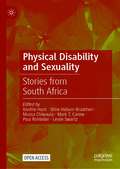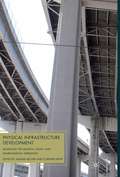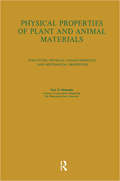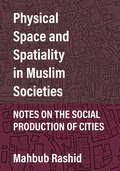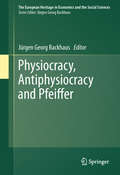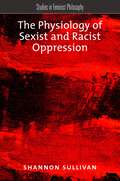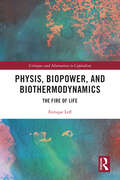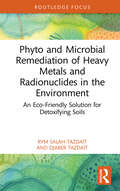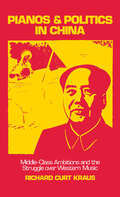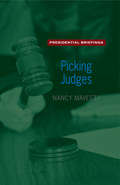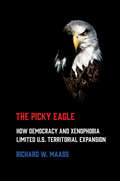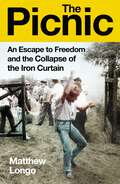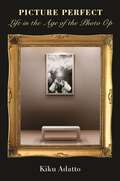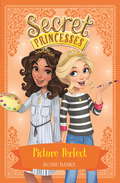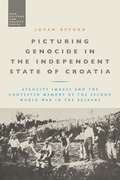- Table View
- List View
Physical Disability and Sexuality: Stories from South Africa
by Leslie Swartz Poul Rohleder Xanthe Hunt Stine Hellum Braathen Mussa Chiwaula Mark T. CarewThis open access edited volume explores physical disability and sexuality in South Africa, drawing on past studies, new research conducted by the editors, and first-person narratives from people with physical disabilities in the country. Sexuality has long been a site of oppression and discrimination for people with disabilities based on myths and misconceptions, and this book explores how these play out for people with physical disabilities in the South African setting. One myth with which the book is centrally concerned, is that people with disabilities are unable to have sex, or are seen as lacking sexuality by society at large. Societal understandings of masculinity, femininity, bodies and attractiveness, often lead people with physical disabilities to be seen as being undesirable romantic or sexual partners. The contributions in this volume explore how these prevailing social conditions impact on the access to sexual and reproductive healthcare, involvement in romantic relationships, childbearing, and sexual citizenship as a whole, of people with physical disabilities in the Western Cape of the country. The authors' research, and first person contributions by people with physical disabilities themselves, suggest that education and public health policy must change, if the sexual and reproductive health rights and full inclusion of people with disabilities are to be achieved.
Physical Infrastructure Development: Balancing the Growth, Equity, and Environmental Imperatives
by W. Ascher C. KruppThis book addresses the key challenges of balancing economic growth, poverty alleviation, and environmental protection in the development of major physical infrastructure, ranging from transport to energy.
Physical Properties of Plant and Animal Materials: v. 1: Physical Characteristics and Mechanical Properties
by Nuri N. MohseninThis collection of essays by both Western and East European experts examines the efforts to develop strategies for dealing with the environmental crisis both by governments and at the grassroots level of newly emerging green movements.
Physical Security Assessment Handbook: An Insider’s Guide to Securing a Business
by Michael KhairallahPhysical Security Assessment Handbook: An Insider’s Guide to Securing a Business, Second Edition has been fully updated to help you identify threats to your organization and be able to mitigate such threats. The techniques in this comprehensive book outline a step-by-step approach to: Identify threats to your assets Assess physical security vulnerabilities Design systems and processes that mitigate the threats Set a budget for your project and present it to company managers Acquire the products through competitive bidding Implement the recommended solutions Each chapter walks you through a step in the assessment process, providing valuable insight and guidance. There are illustrations and checklists that help simplify the process and ensure that the right course is taken to secure your company. This book provides seasoned advice on the competitive bidding process as well as legal issues involved in facility security. After reading it, you will know how to assess your security needs, specify the right products, and oversee and manage the project and installation. It concludes with project implementation, and the necessary follow-up after installation, to verify the proper use of the new security solutions. Physical Security Assessment Handbook, Second Edition provides a structure for best practices in both specifying system components as well as managing the acquisition and implementation process. It represents the culmination of the author’s 44 years of experience in the design, installation, and project management of security system solutions. This is a valuable resource for security managers, security consultants, and even experienced industry professionals to best approach and organize security assessment projects.
Physical Security Assessment Handbook: An Insider’s Guide to Securing a Business
by Michael KhairallahPhysical Security Assessment Handbook: An Insider’s Guide to Securing a Business, Second Edition has been fully updated to help you identify threats to your organization and be able to mitigate such threats. The techniques in this comprehensive book outline a step-by-step approach to: Identify threats to your assets Assess physical security vulnerabilities Design systems and processes that mitigate the threats Set a budget for your project and present it to company managers Acquire the products through competitive bidding Implement the recommended solutions Each chapter walks you through a step in the assessment process, providing valuable insight and guidance. There are illustrations and checklists that help simplify the process and ensure that the right course is taken to secure your company. This book provides seasoned advice on the competitive bidding process as well as legal issues involved in facility security. After reading it, you will know how to assess your security needs, specify the right products, and oversee and manage the project and installation. It concludes with project implementation, and the necessary follow-up after installation, to verify the proper use of the new security solutions. Physical Security Assessment Handbook, Second Edition provides a structure for best practices in both specifying system components as well as managing the acquisition and implementation process. It represents the culmination of the author’s 44 years of experience in the design, installation, and project management of security system solutions. This is a valuable resource for security managers, security consultants, and even experienced industry professionals to best approach and organize security assessment projects.
Physical Space and Spatiality in Muslim Societies: Notes on the Social Production of Cities
by Mahbub RashidMahbub Rashid embarks on a fascinating journey through urban space in all of its physical and social aspects, using the theories of Foucault, Bourdieu, Lefebvre, and others to explore how consumer capitalism, colonialism, and power disparity consciously shape cities. Using two Muslim cities as case studies, Algiers (Ottoman/French) and Zanzibar (Ottoman/British), Rashid shows how Western perceptions can only view Muslim cities through the lens of colonization—a lens that distorts both physical and social space. Is it possible, he asks, to find a useable urban past in a timeline broken by colonization? He concludes that political economy may be less relevant in premodern cities, that local variation is central to the understanding of power, that cities engage more actively in social reproduction than in production, that the manipulation of space is the exercise of power, that all urban space is a conscious construct and is therefore not inevitable, and that consumer capitalism is taking over everyday life. Ultimately, we reconstruct a present from a fragmented past through local struggles against the homogenizing power of abstract space.
Physiocracy, Antiphysiocracy and Pfeiffer (The European Heritage in Economics and the Social Sciences #10)
by Jürgen Georg Georg BackhausPhysiocracy, or the economic theory that a nation’s wealth comes from is agricultural and land development, was a popular school of thought in France in the 18th century. The contribution and significance of the Physiocrats and Antiphysiocrats are explored in detail through chapter contributions by economists, philosophers, and social historians. The book concludes that neither the Physiocrats, nor the Antiphysiocrats were pure profit maximizers and that they all had the well-being of the commonwealth in mind. It brings to light previous studies only conducted in German and is the first analysis of Pfeiffer in a century, making the book of interest to any student or scholar of political economy and the history of economic thought. The contribution and significance of the Physiocrats and Antiphysiocrats are explored in detail through chapter contributions by economists, philosophers, and social historians. It brings to light previous studies only conducted in German and is the first analysis of Pfeiffer in a century, making the book of interest to any student or scholar of political economy and the history of economic thought.
The Physiology of Sexist and Racist Oppression (Studies in Feminist Philosophy)
by Shannon SullivanWhile gender and race often are considered socially constructed, this book argues that they are physiologically constituted through the biopsychosocial effects of sexism and racism. This means that to be fully successful, critical philosophy of race and feminist philosophy need to examine not only the financial, legal, political and other forms of racist and sexism oppression, but also their physiological operations. Examining a complex tangle of affects, emotions, knowledge, and privilege, The Physiology of Sexist and Racist Oppression develops an understanding of the human body whose unconscious habits are biological. On this account, affect and emotion are thoroughly somatic, not something "mental" or extra-biological layered on top of the body. They also are interpersonal, social, and can be transactionally transmitted between people. Ranging from the stomach and the gut to the hips and the heart, from autoimmune diseases to epigenetic markers, Sullivan demonstrates the gastrointestinal effects of sexual abuse that disproportionately affect women, often manifesting as IBS, Crohn's disease, or similar functional disorders. She also explores the transgenerational effects of racism via epigenetic changes in African American women, who experience much higher pre-term birth rates than white women do, and she reveals the unjust benefits for heart health experienced by white people as a result of their racial privilege. Finally, developing the notion of a physiological therapy that doesn't prioritize bringing unconscious habits to conscious awareness, Sullivan closes with a double-barreled approach for both working for institutional change and transforming biologically unconscious habits. The Physiology of Sexist and Racist Oppression skillfully combines feminist and critical philosophy of race with the biological and health sciences. The result is a critical physiology of race and gender that offers new strategies for fighting male and white privilege.
PHYSIOLOGY SEXIST & RACIST OPPRESS SFP C (Studies in Feminist Philosophy)
by Shannon SullivanWhile gender and race often are considered socially constructed, this book argues that they are physiologically constituted through the biopsychosocial effects of sexism and racism. This means that to be fully successful, critical philosophy of race and feminist philosophy need to examine not only the financial, legal, political and other forms of racist and sexism oppression, but also their physiological operations. Examining a complex tangle of affects, emotions, knowledge, and privilege, The Physiology of Sexist and Racist Oppression develops an understanding of the human body whose unconscious habits are biological. On this account, affect and emotion are thoroughly somatic, not something "mental" or extra-biological layered on top of the body. They also are interpersonal, social, and can be transactionally transmitted between people. Ranging from the stomach and the gut to the hips and the heart, from autoimmune diseases to epigenetic markers, Sullivan demonstrates the gastrointestinal effects of sexual abuse that disproportionately affect women, often manifesting as IBS, Crohn's disease, or similar functional disorders. She also explores the transgenerational effects of racism via epigenetic changes in African American women, who experience much higher pre-term birth rates than white women do, and she reveals the unjust benefits for heart health experienced by white people as a result of their racial privilege. Finally, developing the notion of a physiological therapy that doesn't prioritize bringing unconscious habits to conscious awareness, Sullivan closes with a double-barreled approach for both working for institutional change and transforming biologically unconscious habits. The Physiology of Sexist and Racist Oppression skillfully combines feminist and critical philosophy of race with the biological and health sciences. The result is a critical physiology of race and gender that offers new strategies for fighting male and white privilege.
Physis, Biopower, and Biothermodynamics: The Fire of Life (ISSN)
by Enrique LeffBuilding upon the idea that our current "environmental question" arises from the history of metaphysics—which privileged thought about Being (or ontology) over the conditions of life—this book reinterprets Heraclitus’s notion of physis as the fundamental, emergent potency of life, as the category to-be-thought by thinkers. In so doing, it deconstructs the interpretation offered by Heidegger and so stresses the struggle between the creative force of life and its subjection to the human Logos or "meaning". Physis, understood as the pre-ontological potentiality of life itself, thus becomes the cornerstone of a materialist philosophy of life.Following engagements with the work of Nietzsche, Foucault, and Janicaud to explore the significance of human intervention into the realm of life via the "will to power", "biopower" and the "power of rationality" respectively, the author explores twentieth-century rearticulations of the concept of physis through a range of developments in biothermodynamics, thus grounding a new philosophy of life and a new bioeconomics in a revisited biothermodynamics centered on the concept of negentropy.An extensive engagement with the history and development of thought about the generative force of life on Earth, Physis, Biopower, Biothermodynamics, and Bioeconomics: The Fire of Life will appeal to scholars of philosophy, social theory, and political theory with interests in environmental thought, political ecology, and questions of sustainability.
Physis, Biopower, and Biothermodynamics: The Fire of Life (ISSN)
by Enrique LeffBuilding upon the idea that our current "environmental question" arises from the history of metaphysics—which privileged thought about Being (or ontology) over the conditions of life—this book reinterprets Heraclitus’s notion of physis as the fundamental, emergent potency of life, as the category to-be-thought by thinkers. In so doing, it deconstructs the interpretation offered by Heidegger and so stresses the struggle between the creative force of life and its subjection to the human Logos or "meaning". Physis, understood as the pre-ontological potentiality of life itself, thus becomes the cornerstone of a materialist philosophy of life.Following engagements with the work of Nietzsche, Foucault, and Janicaud to explore the significance of human intervention into the realm of life via the "will to power", "biopower" and the "power of rationality" respectively, the author explores twentieth-century rearticulations of the concept of physis through a range of developments in biothermodynamics, thus grounding a new philosophy of life and a new bioeconomics in a revisited biothermodynamics centered on the concept of negentropy.An extensive engagement with the history and development of thought about the generative force of life on Earth, Physis, Biopower, Biothermodynamics, and Bioeconomics: The Fire of Life will appeal to scholars of philosophy, social theory, and political theory with interests in environmental thought, political ecology, and questions of sustainability.
Phyto and Microbial Remediation of Heavy Metals and Radionuclides in the Environment: An Eco-Friendly Solution for Detoxifying Soils (Routledge Focus on Environment and Sustainability)
by Rym Salah-Tazdaït Djaber TazdaïtThis book examines the role that bioremediation can play in the detoxification of soil, water, and air to improve environmental and human health, with a specific focus on heavy metals and radionuclides. Environmental pollution, whether by natural or human causes, with industrial activities being a key player, is a challenge facing all nations across the world. While treatment has typically required the use of expensive technology, one promising solution is the use of phytoremediation, in which plants act by metabolizing or sequestering pollutants. This eco-friendly solution is a good alternative to the standard methods of soil and water treatments. This book provides not only the basic definitions and classification of technologies used for contaminant remediation but also the most recent studies dealing with the selection of new promising microbial stains and plant varieties involved in the treatment of radioactive and heavy metal contaminants. It provides a detailed description of the biochemical mechanisms and genes involved in the bioremediation of radionuclides and heavy metals, offering a clear insight for academics and practitioners interested in in vitro and in situ biological treatment. This book will be of great value to students and scholars interested in environmental pollution and environmental health from across a range of different disciplines, including environmental microbiology and chemistry, ecology and environmental science, biological and environmental engineering and biotechnology.
Phyto and Microbial Remediation of Heavy Metals and Radionuclides in the Environment: An Eco-Friendly Solution for Detoxifying Soils (Routledge Focus on Environment and Sustainability)
by Rym Salah-Tazdaït Djaber TazdaïtThis book examines the role that bioremediation can play in the detoxification of soil, water, and air to improve environmental and human health, with a specific focus on heavy metals and radionuclides. Environmental pollution, whether by natural or human causes, with industrial activities being a key player, is a challenge facing all nations across the world. While treatment has typically required the use of expensive technology, one promising solution is the use of phytoremediation, in which plants act by metabolizing or sequestering pollutants. This eco-friendly solution is a good alternative to the standard methods of soil and water treatments. This book provides not only the basic definitions and classification of technologies used for contaminant remediation but also the most recent studies dealing with the selection of new promising microbial stains and plant varieties involved in the treatment of radioactive and heavy metal contaminants. It provides a detailed description of the biochemical mechanisms and genes involved in the bioremediation of radionuclides and heavy metals, offering a clear insight for academics and practitioners interested in in vitro and in situ biological treatment. This book will be of great value to students and scholars interested in environmental pollution and environmental health from across a range of different disciplines, including environmental microbiology and chemistry, ecology and environmental science, biological and environmental engineering and biotechnology.
Pianos and Politics in China: Middle-Class Ambitions and the Struggle over Western Music
by Richard Curt KrausIn China, a nation where the worlds of politics and art are closely linked, Western classical music was considered during the cultural revolution to be an imperialist intrusion, in direct conflict with the native aesthetic. In this revealing chronicle of the relationship between music and politics in twentieth-century China, Richard Kraus examines the evolution of China's ever-changing disposition towards European music and demonstrates the steady westernization of Chinese music. Placing China's cultural conflicts in global perspective, he traces the lives of four Chinese musicians and reflects on how their experiences are indicative of China's place at the furthest edge of an expanding Western international order.
Picking Judges
by Nancy MaveetyWhat defines a president? Is it policymaking? A good relationship with the American people? Or is it legacy? Most would argue that legacy imprints a president in the American consciousness. A president's federal judicial appointees may be his or her most lasting political legacy. Because federal judges serve for life, their legal policymaking endures long after a president's term in office is over. Presidents who care about serving their mandate, who desire to maximize their policy agenda, and who wish to influence the nation's constitutional fabric appoint as many federal judges as possible.This new volume in the Presidential Briefings series shows how the president's appointment power has expanded beyond its bare constitutional outlines. In exercising their constitutional powers while paying heed to political opportunities, presidents and the Senate have together created our modern judicial appointment politics. Presidents consider a host of demographic and ideological factors, candidate qualities, and electoral politics.Nancy Maveety examines the dynamics of screening and choosing judicial nominees and analyses the institutional calculus in securing their confirmation in the face of senatorial obstruction. Maveety shows how a president can adapt to particular circumstances and provides an outline for synergistically staffing the federal judiciary, thus securing a legacy for all time.
Picking Judges
by Nancy MaveetyWhat defines a president? Is it policymaking? A good relationship with the American people? Or is it legacy? Most would argue that legacy imprints a president in the American consciousness. A president's federal judicial appointees may be his or her most lasting political legacy. Because federal judges serve for life, their legal policymaking endures long after a president's term in office is over. Presidents who care about serving their mandate, who desire to maximize their policy agenda, and who wish to influence the nation's constitutional fabric appoint as many federal judges as possible.This new volume in the Presidential Briefings series shows how the president's appointment power has expanded beyond its bare constitutional outlines. In exercising their constitutional powers while paying heed to political opportunities, presidents and the Senate have together created our modern judicial appointment politics. Presidents consider a host of demographic and ideological factors, candidate qualities, and electoral politics.Nancy Maveety examines the dynamics of screening and choosing judicial nominees and analyses the institutional calculus in securing their confirmation in the face of senatorial obstruction. Maveety shows how a president can adapt to particular circumstances and provides an outline for synergistically staffing the federal judiciary, thus securing a legacy for all time.
The Picky Eagle: How Democracy and Xenophobia Limited U.S. Territorial Expansion
by Richard W. MaassThe Picky Eagle explains why the United States stopped annexing territory by focusing on annexation's domestic consequences, both political and normative. It describes how the U.S. rejection of further annexations, despite its rising power, set the stage for twentieth-century efforts to outlaw conquest. In contrast to conventional accounts of a nineteenth-century shift from territorial expansion to commercial expansion, Richard W. Maass argues that U.S. ambitions were selective from the start.By presenting twenty-three case studies, Maass examines the decision-making of U.S. leaders facing opportunities to pursue annexation between 1775 and 1898. U.S. presidents, secretaries, and congressmen consistently worried about how absorbing new territories would affect their domestic political influence and their goals for their country. These leaders were particularly sensitive to annexation's domestic costs where xenophobia interacted with their commitment to democracy: rather than grant political representation to a large alien population or subject it to a long-term imperial regime, they regularly avoided both of these perceived bad options by rejecting annexation. As a result, U.S. leaders often declined even profitable opportunities for territorial expansion, and they renounced the practice entirely once no desirable targets remained.In addition to offering an updated history of the foundations of U.S. territorial expansion, The Picky Eagle adds important nuance to previous theories of great-power expansion, with implications for our understanding of U.S. foreign policy and international relations.
The Picnic: An Escape to Freedom and the Collapse of the Iron Curtain
by Matthew LongoA dramatic reconstruction of the greatest border breach in Cold War history and its tumultuous aftermath. 'Evoke[s] the dramatic events in vivid colour . . . fascinating' Katja Hoyer, Telegraph *****'This little gem of a book . . . intensely moving' Sunday Times* A GUARDIAN BIGGEST FICTION AND NON-FICTION FOR 2024 * A WATERSTONES ‘BOOK YOU NEED TO READ IN 2024’ * A FOYLES TOP TEN READ FOR JANUARY 2024 *In August 1989, a group of Hungarian activists did the unthinkable: they entered the forbidden militarised zone of the Iron Curtain - and held a picnic.Word had spread of what was going to happen. On wisps of rumour, thousands of East German 'holiday-makers' had made their way to the border between Hungary and Austria, awaiting an opportunity, fearing prison, surveilled by lurking Stasi agents. The stage was set for the greatest border breach in Cold War history: that day hundreds would cross from the Communist East to the longed-for freedom of the West. The fall of the Berlin Wall, the end of the Soviet Union - the so-called end of history - all would flow from those dramatic hours.Drawing on dozens of original interviews with those involved - activists and border guards, escapees and secret police, as well as the last Communist prime minister of Hungary - Matthew Longo reconstructs this world-shaping event and its tumultuous aftermath. Freedom had been won but parents had been abandoned and families divided. Love affairs faltered and new lives had to be built from scratch.The Picnic is the story of a moment when the tide of history turned. It shows how freedom can be both dream and disillusionment, and how all we take for granted can vanish in an instant.'A pivotal – and exhilarating – moment in late 20th-century history . . . gripping' Observer‘Captivating . . . a vivid, fast-paced narrative’ New York Times
Picture Perfect: Life in the Age of the Photo Op
by Kiku AdattoWe say the camera doesn't lie, but we also know that pictures distort and deceive. In Picture Perfect, Kiku Adatto brilliantly examines the use and abuse of images today. Ranging from family albums to Facebook, political campaigns to popular movies, images of war to pictures of protest. Adatto reveals how the line between the person and the pose, the real and the fake, news and entertainment is increasingly blurred. New technologies make it easier than ever to capture, manipulate, and spread images. But even in the age of the Internet, we still seek authentic pictures and believe in the camera's promise to document, witness, and interpret our lives.
Picture Perfect: Life in the Age of the Photo Op - New Edition
by Kiku AdattoWe say the camera doesn't lie, but we also know that pictures distort and deceive. In Picture Perfect, Kiku Adatto brilliantly examines the use and abuse of images today. Ranging from family albums to Facebook, political campaigns to popular movies, images of war to pictures of protest. Adatto reveals how the line between the person and the pose, the real and the fake, news and entertainment is increasingly blurred. New technologies make it easier than ever to capture, manipulate, and spread images. But even in the age of the Internet, we still seek authentic pictures and believe in the camera's promise to document, witness, and interpret our lives.
Picture Perfect: Life in the Age of the Photo Op - New Edition
by Kiku AdattoWe say the camera doesn't lie, but we also know that pictures distort and deceive. In Picture Perfect, Kiku Adatto brilliantly examines the use and abuse of images today. Ranging from family albums to Facebook, political campaigns to popular movies, images of war to pictures of protest. Adatto reveals how the line between the person and the pose, the real and the fake, news and entertainment is increasingly blurred. New technologies make it easier than ever to capture, manipulate, and spread images. But even in the age of the Internet, we still seek authentic pictures and believe in the camera's promise to document, witness, and interpret our lives.
Picture Perfect: Book 12 (Secret Princesses #12)
by Rosie BanksA gorgeous new series about magical princesses and best friends. Best friends Charlotte and Mia can't bear it when Charlotte's family moves far away. But when they become trainee Secret Princesses they begin an amazing adventure together - and they can see each other whenever they like!Mean Princess Poison has cast a spell on four of the Secret Princesses and made them forget all about their magic. Can the girls break Princess Poison's spell and grant a wish for another girl just like them?
Picturing Genocide in the Independent State of Croatia: Atrocity Images and the Contested Memory of the Second World War in the Balkans (War, Culture and Society)
by Jovan ByfordPicturing Genocide in the Independent State of Croatia examines the role which atrocity photographs played, and continue to play, in shaping the public memory of the Second World War in the countries of the former Yugoslavia. Focusing on visual representations of one of the most controversial and politically divisive episodes of the war -- genocidal violence perpetrated against Serbs, Jews, and Roma by the pro-Nazi Ustasha regime in the Independent State of Croatia (1941-1945) -- the book examines the origins, history and legacy of violent images. Notably, this book pays special attention to the politics of the atrocity photograph. It explores how images were strategically and selectively mobilized at different times, and by different memory communities and stakeholders, to do different things: justify retribution against political opponents in the immediate aftermath of the war, sustain the discourses of national unity on which socialist Yugoslavia was founded, or, in the post-communist era, prop-up different nationalist agendas, and 'frame' the Yugoslav wars of the 1990s.In exploring this hitherto neglected aspect of Yugoslav history and visual culture, Jovan Byford sheds important light on the intricate nexus of political, cultural and psychological factors which account for the enduring power of atrocity images to shape the collective memory of mass violence.
Picturing Genocide in the Independent State of Croatia: Atrocity Images and the Contested Memory of the Second World War in the Balkans (War, Culture and Society)
by Jovan ByfordPicturing Genocide in the Independent State of Croatia examines the role which atrocity photographs played, and continue to play, in shaping the public memory of the Second World War in the countries of the former Yugoslavia. Focusing on visual representations of one of the most controversial and politically divisive episodes of the war -- genocidal violence perpetrated against Serbs, Jews, and Roma by the pro-Nazi Ustasha regime in the Independent State of Croatia (1941-1945) -- the book examines the origins, history and legacy of violent images. Notably, this book pays special attention to the politics of the atrocity photograph. It explores how images were strategically and selectively mobilized at different times, and by different memory communities and stakeholders, to do different things: justify retribution against political opponents in the immediate aftermath of the war, sustain the discourses of national unity on which socialist Yugoslavia was founded, or, in the post-communist era, prop-up different nationalist agendas, and 'frame' the Yugoslav wars of the 1990s.In exploring this hitherto neglected aspect of Yugoslav history and visual culture, Jovan Byford sheds important light on the intricate nexus of political, cultural and psychological factors which account for the enduring power of atrocity images to shape the collective memory of mass violence.
